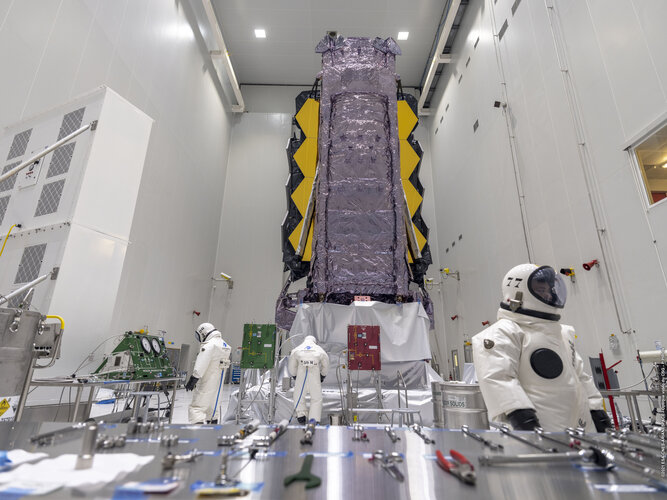The James Webb Space Telescope was fuelled inside the payload preparation facility at Europe’s Spaceport in French Guiana ahead of its launch on Ariane 5.
Webb’s thrusters will use this propellant to make critical course-corrections after separation from Ariane 5, to maintain its prescribed orbit about one and a half million kilometres from Earth, and to repoint the observatory and manage its momentum during operations.
Fuelling any satellite is a particularly delicate operation requiring setup of the equipment and connections, fuelling, and then pressurisation.
Webb’s propellant tanks were filled separately with 79.5 l of dinitrogen tetroxide oxidiser and 159 l hydrazine. Oxidiser improves the burn efficiency of the hydrazine fuel.
These propellants are extremely toxic so only a few specialists wearing Self-Contained Atmospheric Protective Ensemble, or ‘scape’ suits, remained in the dedicated fuelling hall for fuelling which took 10 days and ended on 3 December.
The next steps will start soon for ‘combined operations’. This is when specialists working separately to prepare Webb and Ariane 5 will come together as one team. They will place Webb atop its Ariane 5 launch vehicle and encapsulate it inside Ariane 5’s fairing.
Then, no longer visible, Webb, joined with its Ariane 5 launch vehicle will be transferred to the Final Assembly building for the final preparations before launch.
Webb will be the largest, most powerful telescope ever launched into space. As part of an international collaboration agreement, ESA is providing the telescope’s launch service using the Ariane 5 launch vehicle. Working with partners, ESA was responsible for the development and qualification of Ariane 5 adaptations for the Webb mission and for the procurement of the launch service by Arianespace.
Webb is an international partnership between NASA, ESA and the Canadian Space Agency (CSA).
Find out more about Webb in ESA’s launch kit and interactive brochure.



 Image:
Webb fuelled for launch
Image:
Webb fuelled for launch